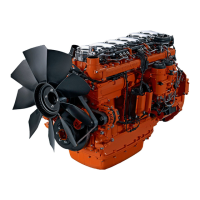© Scania CV 2009 11
Safety precautions for running the engine
Daily inspection
Always visually inspect the engine and engine
compartment before starting the engine and once
you have stopped the engine after running.
This will enable you to easily detect fuel, oil or
coolant leaks, or any other abnormalities which may
require rectification.
Refuelling
There is a risk of fire and explosion when refuelling.
The engine must be stopped and smoking is not
allowed.
Do not overfill the tank due to a risk of expansion,
and close the filler cap properly.
Use only fuel recommended in the service
literature. Fuel of the wrong quality can cause the
engine to malfunction or stop by preventing the
injection pump and injectors from operating as they
should.
This can cause damage to the engine and, possibly,
injury.
Hazardous gases
Only start the engine in a well ventilated area. The
exhaust fumes contain carbon monoxide and nitric
oxides, which are toxic.
If it is run in a enclosed space, there should be an
effective device to extract exhaust gases and
crankcase gases.
Starter lock
If the control panel is not fitted with a key operated
switch, there should be a lock on the engine room to
prevent unauthorised starting of the engine.
Alternatively, a lockable on/off master switch or
battery master switch can be used.
Starter spray
Never use starting spray or similar as a starting aid.
This can cause an explosion in the intake manifold
and possible injury.
Running
The engine must not be run in environments where
there is a risk for explosion as all of the electrical or
mechanical components can generate sparks.
Approaching a running engine always poses a safety
risk. Parts of the body, clothes or dropped tools can
get caught in rotating parts such as the fan and cause
injury.
For personal safety all rotating parts and hot
surfaces must therefore be shielded as much as
possible.

